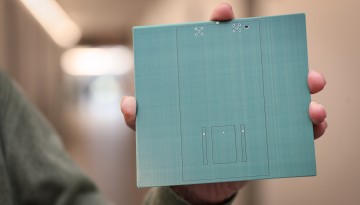Innovative Snow Probes Enhance Pharmaceutical Manufacturing Processes
While crouching behind a boulder on the Bridger Mountains near Bozeman, Montana, Michel Louge watched in awe as the mountainside unleashed a massive avalanche toward him.
The engineer had journeyed into dangerous terrain to deploy specialized probes designed to measure snow density, but he was soon knee-deep in snow.
Louge, professor emeritus of mechanical and aerospace engineering, credits the boulder with shielding him from the avalanche’s full force, and he has remained undeterred from pursuing his science. After decades of engineering probes to monitor mountain snowpack and to study other natural environments, Louge is now publishing research with pharmaceutical company Merck, showing how his technology has been adapted to improve drug manufacturing processes.
“I actually started building the first probe in my garage,” Louge said. “It’s kind of this crazy thing, I wanted to record whether the probe could be detecting snow, and the answer was yes. So we started a research program that led to a whole number of things, and this technology has been building up more capabilities ever since.”
Louge’s probes, developed in collaboration with the company Capacitec, rely on femtofarad capacitance-based technology capable of detecting tiny variations in materials with millimetric spatial resolution. Initially funded by the U.S. Army for avalanche studies, increasingly sophisticated versions of the probes have allowed Louge to transition from measuring environmental conditions to highly sensitive pharmaceuticals powders.
The partnership with Merck emerged when Louge, who was a consultant for the International Fine Particle Research Institute, an industry consortium, was invited to work on a joint project in 2017 focused on Merck’s effort to shift from traditional batch systems to continuous manufacturing, which allows for a constant flow of production, reducing the time, cost and variability involved in making pharmaceuticals.
“It’s like when you cook only one batch of food at a time, it’s inefficient,” Louge said. “Continuous manufacturing can ultimately lower the cost to manufacture drugs. Its enabling technology is instruments. You must continuously monitor what’s going on in your line to ensure that you have product quality, literally at all times.”
A key production process Louge has focused on is tray drying, a method used to remove liquid solvents from pharmaceutical powders that will be pressed into tablets. He and researchers from Merck developed the Smart Tray – a sheet of metal embedded with probes that create an electric field. The invisible field interacts with the powder spread across the tray and as the solvent evaporates, the probes detect and correlate changing electrical properties to how much solvent remains in the powder. This real-time data helps determine the moment the powder is properly dried.
“So instead of having to open up the drying oven, break the vacuum, take a small sample, close the door, analyze the sample in the lab and decide whether or not you want to stop drying, you can tell immediately when you want to stop,” Louge said.
In one test with microcrystalline cellulose powder, the Smart Tray continued to detect changes in solvent content even after a residual gas analyzer, a more common monitoring tool, stopped registering changes.
While the Smart Tray has so far been a proof-of-concept, Louge and Merck have developed another innovation, the Continuous Level Sensor, which is critical for producing uniform tablets with the correct weight.
The sensor monitors the amount of pharmaceutical powder above the feed frame – a device with a rotating mechanism that controls how powder is fed into the tablet compression system – and detects real-time changes, helping to maintain a steady flow and prevent variations in tablet weight and quality.
“We want to make sure the amount of the powder is rigorously constant with time, irrespective of the state of the powder,” Louge said, “whether it is more or less humid or its density has changed in anyway by going through other parts of the manufacturing process, we want the level to be constant and we proved that this could be done with the control system.”
Both devices have been detailed by Louge and his research partners in a series of academic papers and conference presentations, with the most recent paper being published Aug. 2 in the American Association of Pharmaceutical Sciences Journal.
“Merck has been forward-thinking in its approach, choosing to publish the research and data generated from these collaborations openly,” Louge said. “This move not only benefits the industry by advancing drug manufacturing processes but also helps streamline the FDA approval process as certain tools and technologies become standardized.”
While Louge continues his partnership with Merck, he is also exploring new possibilities for his probes, including recent work with geologists in New Zealand studying volcanic eruptions. Modified versions of his probes, designed to withstand extreme heat will eventually be tested to gather data on high-speed flows of hot ash and gases, potentially offering new insights into one of the most dangerous natural phenomena on Earth.
“Nobody knows what’s going on deep inside these flows,” Louge said. “Just like our Swiss colleagues did 10 years ago by implementing this technology in large powder snow avalanches, these probes could actually figure it out.”

